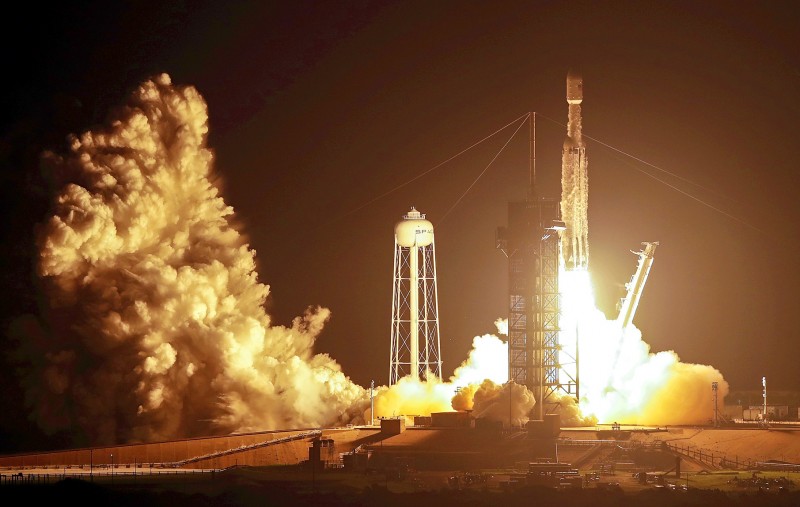《TAIPEI TIMES》 Tsai hails launch as Taiwan space tech milestone

A SpaceX Falcon Heavy rocket lifts off from pad 39A at the Kennedy Space Center in Cape Canaveral, Florida, early yesterday. Photo: AP
FORMOSAT-7: The satellite, a joint project with the US, demonstrated Taiwan’s contributions and cutting-edge technology, the AIT’s Brent Christensen said
/ Staff writer, with CNA and AP, TAIPEI and CAPE CANAVERAL, Florida
President Tsai Ing-wen (蔡英文) yesterday lauded the launch of Formosat-7, the second satellite constellation jointly built by Taiwan and the US, as a milestone in the nation’s space technology.
Formosat-7 was launched into orbit by a SpaceX Falcon Heavy rocket at 2:30pm yesterday from the Kennedy Space Center in Florida, with the president watching the launch live at the National Space Organization (NSPO) in Hsinchu.
Tsai attributed the achievement to the hard work of the NSPO’s research and development team, saying: “Every one of you is a space hero and the pride of Taiwan.”
The launch of Formosat-5 on Aug. 24, 2017, proved to the world that Taiwan has independent space research and development capability, and with the launch of Formosat-7, the nation now shines bright on the international stage, Tsai said.
Formosat-5, also an Earth observation satellite operated by the NSPO, was launched from Vandenberg Air Force Base in California.
Formosat-7 is the largest cooperative project between Taiwan and the US, Tsai said, adding that the satellite would conduct meteorological observations free from the restrictions of geography or weather, enabling Taiwan to obtain more accurate meteorological data.
The collected data can be shared with other nations for the benefit of humankind, she added.
Also at the launch was American Institute in Taiwan (AIT) Director Brent Christensen, who said that Formosat-7 demonstrated that Taiwan’s contributions and cutting-edge technology extend not just around the world, but also above it.
“Our shared traditions of innovation and entrepreneurship are ensuring that we all benefit from our ongoing scientific engagement as we face the challenges of the 21st century,” he said.
According to the NSPO, 91 minutes into the launch, Formosat-7 detached from the rocket that carried it and was set to connect to a satellite signal station in Taiwan at about 9pm Taipei time, when a news conference was scheduled.
About three hours after the launch, the satellite passed over a signal reception station in Darwin, Australia, the NSPO said in a press release.
Formosat-7 is to replace Formosat-3, the first Taiwan-US collaborative space program, with state-of-the-art instruments and equipment that collect meteorological, ionospheric and climate data.
Jointly developed by the NSPO and the US’ National Oceanic and Atmospheric Administration, the new satellite platform will deploy six satellites into low inclination orbits to provide low and mid-latitude ionosphere data.
Each satellite is equipped with three US-built payloads, including a radio occultation receiver that receives global navigation satellite system signals from Global Positioning System and Russian global navigation system satellites, the NSPO said.
Including Formosat-7, the Falcon Heavy rocket carried 24 research satellites, as well as a deep space atomic clock, solar sail, a “clean and green” rocket fuel testbed, and human ashes.
It was the third flight of a Falcon Heavy rocket, but the first ordered by the US military.
The US Department of Defense mission, dubbed STP-2 for Space Test Program, is expected to provide data to certify the Falcon Heavy — and reused boosters — for future national security launches. It marked the military’s first ride on a recycled rocket.
Both side boosters landed back at Cape Canaveral several minutes after liftoff, just as they did after a launch in April, but the new core booster missed an ocean platform, not unexpected for this especially difficult mission, SpaceX said.
NASA signed up for a spot on the rocket, along with the US Air Force Research Laboratory, the Planetary Society and Celestis Inc, which offers memorial flights into space.
An astronaut who flew on NASA’s first space station in the 1970s, Skylab’s Bill Pogue, had a bit of his ashes on board, along with more than 150 other deceased people. Pogue died in 2014.
SpaceX said the mission was one of its most challenging launches. The satellites needed to be placed in three different orbits, requiring multiple upper-stage engine firings. It was going to take several hours to release them all.
The Deep Space Atomic Clock by NASA’s Jet Propulsion Laboratory is a technology demonstration aimed at self-flying spacecraft. Barely the size of a toaster oven, the clock is meant to help spacecraft navigate by themselves when far from Earth.
NASA was also testing a "clean and green" alternative to toxic rocket and satellite fuel.
The Planetary Society’s LightSail crowd-funded spacecraft would attempt to become the first orbiting spacecraft to be propelled solely by sunlight. It was the society’s third crack at solar sailing: The first was lost in a Russian rocket failure in 2005, while the second had a successful test flight in 2015.
新聞來源:TAIPEI TIMES
















